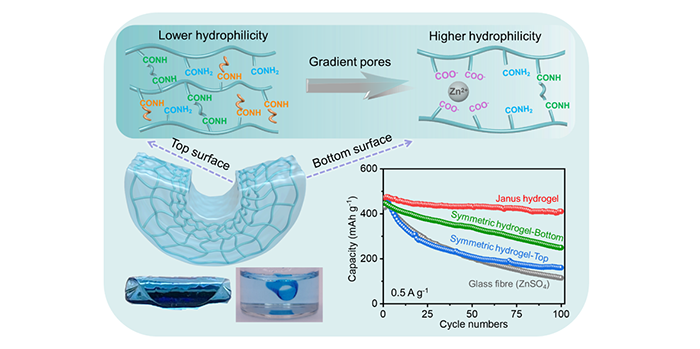Researchers Develop an Integrated Janus Hydrogel with Different Hydrophilicities and Gradient Pore Structures for High-Performance Zinc-Ion Batteries
Aqueous Zn-ion batteries (AZIBs) are promising candidates for grid-scale energy storage technology because of their intrinsic high-safety, low-cost and high energy-intensity, but their commercialization relies heavily on addressing scientific and technical gaps, particularly the capacity-stability trade-off arising from water in electrolytes.
Water molecules in electrolytes play a pivotal role in enhancing the kinetics and capacity of the cathode; however, an excess of water in AZIBs leads to reduced stability of cathode and corrosion of the Zn anode. Achieving high-performance ZIBs necessitates an electrolyte with a lower water content near the anode and a relatively higher water content near the cathode.
Compared to liquid electrolytes, hydrogel electrolytes can confine liquid electrolytes and provide the potential to customize surfaces by modifying both the functional groups and polymer frameworks due to their quasisolid nature. Regretfully, the networks of hydrogel electrolytes employed in aqueous zinc-ion batteries usually maintain a uniform structure, guaranteeing an equitable distribution of water to both the anode and cathode sides. Thereby, a hydrogel electrolyte with different hydrophilicities to meet the different requirements of anodes and cathodes is highly desired.
Recently, a research group led by Prof. YANG Weishen and Prof. ZHU Kaiyue from the Dalian Institute of Chemical Physics of the Chinese Academy of Sciences developed an integrated Janus hydrogel electrolyte characterized by different hydrophilicities (i.e., water activity) on its two surfaces and gradient pore structures within its bulk.
This study was published in Energy & Environmental Science on May 09.
In cross-sectional view of the Janus hydrogel, a gradient in pore size, ranging from large to small, is established in conjunction with the reduction in hydrophilicity, concurrently facilitating rapid ionic transport. The surface featuring lower hydrophilicity and a smaller pore size was oriented towards the Zn anode, while the opposite surface was directed towards the cathode, thus effectively addressing the challenges associated with both the anode and cathode. Employing such Janus hydrogel electrolytes, zinc-ion batteries exhibit both high capacity and excellent long-term cycling stability, far surpassing the performances of ZIBs using symmetric hydrogel electrolytes and liquid electrolytes with widely used glass fibre separators.
Specifically, the coin-type Zn||(NH4)2V10O25·8H2O cell using Janus hydrogel electrolytes attains a capacity of 470 mAh g-1 at 0.5 A g-1, with an impressive 87% capacity retention after 100 cycles. Moreover, the corresponding pouch cell with an area of 22.5 cm2 delivered a substantial capacity of 48 mAh and excellent capacity retention of 85% after 150 cycles at 200 mA. Remarkably, the pouch cell works reliably even when subjected to cutting, heavy loading or bending, positioning itself as a promising candidate for flexible and wearable electronics.
"The unique hydrogel structure and novel electrolyte design strategy lay the foundation for the future discovery of new and better ZIB electrolytes and the development of viable strategies to improve ZIB performance." said Prof. YANG.
The article links: https://doi.org/10.1039/D4EE01018C

